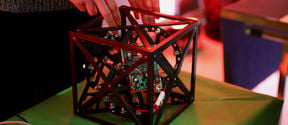In Metsähovi space is at the end of the radio telescope

The location of Metsähovi in Kylmälä, Kirkkonummi has been carefully planned as radio interference must not disturb cutting edge astronomical research. Visitors are therefore asked to switch off all electronic equipment before entering the protected zone. The introductory tour arranged as part of the Kirkkonummi Day on Sunday, 28 August is a possibility for people to see space closer than ever before.
Joni Tammi, Director of Metsähovi, what kind of research is done at Metsähovi?
We study the Sun’s activity, the Earth’s rotation and active galaxies at Metsähovi. The main research equipment at Metsähovi is a 14-metre radio telescope, which is used around the clock on every day of the year. We have made continuous radio observations of active galaxies and the Sun since the 1980s, which is a record-long time period on international scale. The operation of the radio telescope will not be interrupted on the open day, some of the research staff will continue the observation.
How far into space can the research equipment at Metsähovi see?
In clear weather at night, our own galaxy, the Milky Way, is visible in the sky to the naked eye and, if you have good eyesight, you will even be able to see the neighbouring galaxy, Andromeda, at a distance of two million light years. The researched active galaxies, instead, are extremely distant objects. It has taken light and the radio waves we detect billions of light years to reach us here on the Earth. Radio waves are extremely weak, and therefore enormous radio telescopes and an interference-free environment are required to detect them.
Why is the Earth’s rotation studied?
The Earth’s rotation means that night and day alternate. Metsähovi is involved in measurements in which dozens of radio telescopes around the world define the speed and direction of the Earth’s rotation with extreme accuracy. The extremely gradual slowing down detected in these measurements is mostly caused by the Moon and large earthquakes and even the land uplift after the ice age, which is visible in Finland. The impacts are microscopic but, in the long term, they can be detected in the most accurate measurements. This slowing down is compensated for by adding leap seconds as necessary. Last time this was done just over a year ago.
What does the future look like in space?
A person looking into space from the Earth’s surface sees the same view as his ancestors did one hundred, one thousand or one million years ago, and the same stars and constellations will be seen in future, too. With help of telescopes, radio telescopes and satellites, we can now see more and further than we could have even imagined some time ago. The space near the Earth will become more and more familiar to us as probes sent by humanity explore the neighbouring planets and increasingly sophisticated satellites study the Earth as a planet. New possibilities and needs are opening up in space research as nanosatellites have become more common. Finland’s first satellite Aalto-1, which was planned and built at Aalto University, is currently waiting to be launched into space. Metsähovi has previously been involved in several large space research projects through both technology and observations. At the moment, we are investigating the possibility to use our smaller radio telescopes to support the research carried out with nanosatellites. Students who are interested in space can find exciting research and development areas in various fields, whether their interests lie in space technology, astronomy, building equipment or almost anything.
Further information and instructions for the open day in Metsähovi on 28 August can be found on the event website www.metsahovi.fi/avoimetovet (in Finnish)
Contact information:
Joni Tammi, Director of Metsähovi
telephone: +358 29 442 4858 (on working days 9–16)
[email protected]
metsahovi.aalto.fi
www.facebook.com/metsahovi
#metsahovi
- Published:
- Updated:
Read more news

Aalto ARTS alum Vidha Samya’s artwork featured at the Venice Biennale 2024
The Pavilion of Finland presents ‘The pleasures we choose’ at the 60th International Art Exhibition – La Biennale di Venezia until 24 November 2024.
IoT Forge donates EUR 1 million to the School of Engineering
The donation will be used for research and education on the Industrial Internet and digital twins.
Join us for the first Aalto Open Science Award Ceremony
All Aaltonians are welcome – no registration required!